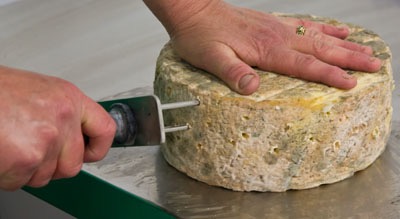
Blue cheeses are the result of moulds that produced blue pigments. Originally cheeses must have been accidentally contaminated by natural moulds floating in the air as spores. Once the mould had grown, it would colonise cheese cellars or storage caves and subsequent cheeses stored there would also be contaminated.
Modern blue cheese production minimises the chances of the mould failing to grow. A suspension of the mould spores is either added to milk at the same time as starter bacteria or is sprayed over or injected into curd pieces which have been drained of the liquid component of milk, whey.
The mould used to make blue cheese is called Penicillium roquefortii, named after Roquefort in France.
The cheese has to be porous since the mould needs oxygen and space to grow, so pressing – the compression of curd in the mould, used for some other types of cheese – is avoided.
The cheeses drain slowly and are relatively soft. They have to be turned each day or they lose shape.
The temperature and humidity vary according to the type of cheese and its age. Typical conditions at between 41 to 59ºF (5 to 15°C) with humidity of 90-95%. Too high humidity encourages excessive growths of yeast and bacteria; to low causes the cheese to crack.
As the cheese matures, the supply of oxygen to the mould growing in the pores can be increased by piercing the cheese with stainless steel needles. For Stilton cheese, 4-48 holes maybe made at each piercing. The former use of copper needles led to the popular misconception that the blue colouring was caused by copper wires oxidising in the cheese. As the mould grows it not only produces the blue colour, but also enzymes. These break down the fats and proteins, producing the characteristic flavour, and making that cheese softer.
Picture Credit : Google

